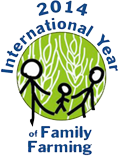Items in the category "Agricultural Research"
 [Document] 2012 has been a highly productive year. The Global Forum has reinforced its status as the unique multi-stakeholder body addressing agricultural research, extension, education and enterprise and their role in national development (here termed agricultural research-for-development, AR4D). Demands...
[Document] 2012 has been a highly productive year. The Global Forum has reinforced its status as the unique multi-stakeholder body addressing agricultural research, extension, education and enterprise and their role in national development (here termed agricultural research-for-development, AR4D). Demands...
 [Document] Mark Holderness, GFAR Executive Secretary, was invited as a moderator for the Network development meeting of the Eurasian Centre for Food Security (ECFS) in Moscow, Russian Federation, from 18 to 20 November 2013. Dr Holderness gave a keynote presentation â€Shaping the future together...
[Document] Mark Holderness, GFAR Executive Secretary, was invited as a moderator for the Network development meeting of the Eurasian Centre for Food Security (ECFS) in Moscow, Russian Federation, from 18 to 20 November 2013. Dr Holderness gave a keynote presentation â€Shaping the future together...
 [Document]
[Document]
 [Document]
[Document]
 [Document]
[Document]
 [Document]
[Document]
 [Document]
[Document]
 [Document] This brief series was developed in preparation for the Foresight Breakout Session of the Global Conference on Agricultural Research for Development (GCARD 2012) and the Global Foresight Hub1. The briefs were written to communicate to a wider audience, such as policy makers, civil society...
[Document] This brief series was developed in preparation for the Foresight Breakout Session of the Global Conference on Agricultural Research for Development (GCARD 2012) and the Global Foresight Hub1. The briefs were written to communicate to a wider audience, such as policy makers, civil society...
 [Document]
[Document]
 [Document]
[Document]
 [Document]
[Document]
 [Document] In this paper/presentation addressing CG perspectives in research on agro-biodiversity, the focus and emphasis is on the plant dimension of agricultural biodiversity, with particular emphasis on the in situ conservation and on-farm management and use of agro-biodiversity.
[Document] In this paper/presentation addressing CG perspectives in research on agro-biodiversity, the focus and emphasis is on the plant dimension of agricultural biodiversity, with particular emphasis on the in situ conservation and on-farm management and use of agro-biodiversity.
 [Document] The Wheat Initiative1 aims to encourage and support the development of a vibrant global wheat public-private research community sharing resources, capabilities, data and ideas to improve wheat productivity, quality and sustainable production around the world.
[Document] The Wheat Initiative1 aims to encourage and support the development of a vibrant global wheat public-private research community sharing resources, capabilities, data and ideas to improve wheat productivity, quality and sustainable production around the world.
 [Document] The central question posed for this Breakout Sub-Session is “What role smallholder farmers now play and could play in meeting the future needs in food and nutrition security, poverty alleviation and sustainable management of natural resources?” Elaborating on this, more specific...
[Document] The central question posed for this Breakout Sub-Session is “What role smallholder farmers now play and could play in meeting the future needs in food and nutrition security, poverty alleviation and sustainable management of natural resources?” Elaborating on this, more specific...
 [Document] The farmers, fishers and herders who live on less than US$1.25 per day live complex, highly adaptive lives where individual technical solutions in and of themselves have limited impact. Recognizing this complexity and the importance of working with stakeholders to understand and design solutions...
[Document] The farmers, fishers and herders who live on less than US$1.25 per day live complex, highly adaptive lives where individual technical solutions in and of themselves have limited impact. Recognizing this complexity and the importance of working with stakeholders to understand and design solutions...
 [Document] The problems being addressed in this session are related to ensuring global food and nutrition security, as well as promoting resilience in production systems and delivering ecosystem services through agricultural biodiversity. Whole landscape management approaches embody biodiversity management,...
[Document] The problems being addressed in this session are related to ensuring global food and nutrition security, as well as promoting resilience in production systems and delivering ecosystem services through agricultural biodiversity. Whole landscape management approaches embody biodiversity management,...
 [Document] The current and future food security of South Asian countries has twin challenges of resource fatigue and decelerating productivity growth of food grain crops. Realizing the importance of these issues not only at national level but also at regional level, the regional NARS (Bangladesh, India,...
[Document] The current and future food security of South Asian countries has twin challenges of resource fatigue and decelerating productivity growth of food grain crops. Realizing the importance of these issues not only at national level but also at regional level, the regional NARS (Bangladesh, India,...
 [Document] The Africa-Brazil and LAC-Brazil Agricultural Innovation Marketplaces (~Mktplace~) have been arising as effective mechanisms for South-South Cooperation supporting smallholders. These are partnerships comprised of public and private not for profit, national and international partners who mobilize...
[Document] The Africa-Brazil and LAC-Brazil Agricultural Innovation Marketplaces (~Mktplace~) have been arising as effective mechanisms for South-South Cooperation supporting smallholders. These are partnerships comprised of public and private not for profit, national and international partners who mobilize...
 [Document] Agricultural research and development (AR4D) systems are basic to finding the long-term solutions to the sources and motors of recurrent crises. AR4D in post-conflict and protracted crises countries invariably suffers from poor research infrastructure and financial means, high staff turnover and...
[Document] Agricultural research and development (AR4D) systems are basic to finding the long-term solutions to the sources and motors of recurrent crises. AR4D in post-conflict and protracted crises countries invariably suffers from poor research infrastructure and financial means, high staff turnover and...
 [Document] Communities worldwide have begun adopting integrated landscape management approaches that work deliberately to support food production, ecosystem conservation and rural livelihoods across landscapes mosaics. While researchers working on landscape and ecosystem processes fully recognize the...
[Document] Communities worldwide have begun adopting integrated landscape management approaches that work deliberately to support food production, ecosystem conservation and rural livelihoods across landscapes mosaics. While researchers working on landscape and ecosystem processes fully recognize the...
 [Document] As a key aspect of the CGIAR reform, the CGIAR’s multi-donor trust fund was formed to pool and harmonize donor funding to support research priorities. By focusing on impact and results, the Fund aims to attract larger contributions from more diverse sources and improve the quality of...
[Document] As a key aspect of the CGIAR reform, the CGIAR’s multi-donor trust fund was formed to pool and harmonize donor funding to support research priorities. By focusing on impact and results, the Fund aims to attract larger contributions from more diverse sources and improve the quality of...
 [Document] This session will: 1)Take stock of North – South and South – South collaboration in agricultural research for development based on recent dialogues and conferences on the topic 2) Identify the main constraints that have limited both North-South and South – South collaboration in agricultural...
[Document] This session will: 1)Take stock of North – South and South – South collaboration in agricultural research for development based on recent dialogues and conferences on the topic 2) Identify the main constraints that have limited both North-South and South – South collaboration in agricultural...
 [Document] In spite of the latent important mutual benefits flowing from their stronger coordination and alignment, CAADP and the CGIAR have remained largely disconnected. In order to overcome this shortcoming three principal actors in CAADP and the CGIAR, namely: (i) the relevant CAADP institutions (Africa...
[Document] In spite of the latent important mutual benefits flowing from their stronger coordination and alignment, CAADP and the CGIAR have remained largely disconnected. In order to overcome this shortcoming three principal actors in CAADP and the CGIAR, namely: (i) the relevant CAADP institutions (Africa...
 [Document] The Global Rice Science Partnership (GRiSP) – with over 900 partners from among international research institutes, national academia, development agencies and donors, extension services, private sector, NGOs and civil societies - develops new rice varieties with increased yield potential,...
[Document] The Global Rice Science Partnership (GRiSP) – with over 900 partners from among international research institutes, national academia, development agencies and donors, extension services, private sector, NGOs and civil societies - develops new rice varieties with increased yield potential,...
 [Document] ASTI collects primary data for low- and middle-income countries through national institutional surveys and in recent years has collected detailed quantitative data on a large number of South Asian and sub-Saharan African countries. In efforts to fill some of the geographical gaps for other...
[Document] ASTI collects primary data for low- and middle-income countries through national institutional surveys and in recent years has collected detailed quantitative data on a large number of South Asian and sub-Saharan African countries. In efforts to fill some of the geographical gaps for other...
 [Document]
[Document]
 [Document]
[Document]
 [Document]
[Document]
 [Document]
[Document]

 [Document]
[Document]  [Document]
[Document] 

